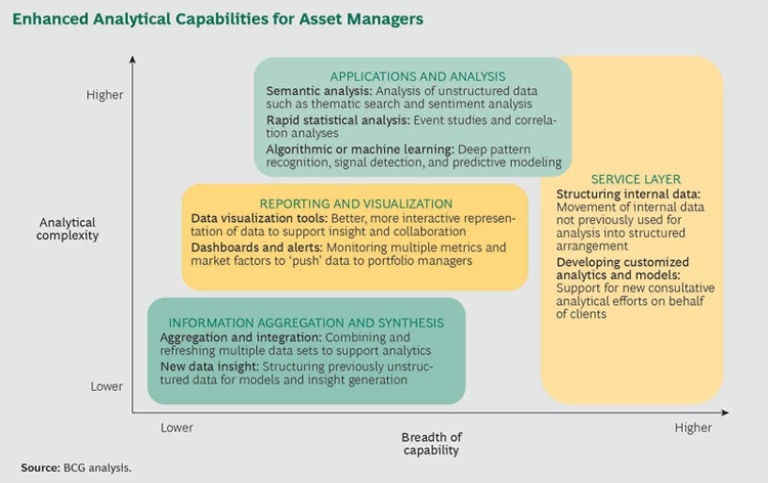Asset managers have always tried to make decisions that yield outstanding investment performance for their clients. The strategies guiding those decisions have evolved, but the underlying tools and analyses have remained largely unchanged.
Today, though, new digitally enabled techniques challenge that status quo and threaten the stability of businesses that adhere strictly to traditional methods. Technologies such as machine learning, artificial intelligence (AI), natural language processing, and predictive reasoning let fast-moving firms and financial technology providers answer questions and model scenarios that push the boundaries of traditional analytics, delivering targeted insights that address a multitude of investment variables with unprecedented precision and speed. In many cases, comprehensive analyses that might otherwise take weeks are now achievable within hours.
Originally used by only a small subset of asset managers, these analytical approaches are bringing intuitive, cost-effective solutions to the mainstream. Promising innovations include machine-learning platforms that can mine huge quantities of structured and unstructured data; predictive-reasoning and artificial-intelligence platforms that can reveal important portfolio effects; rapid statistical analyses that generate event studies and correlation analyses on a massive scale; semantic analyses capable of discerning context and drawing insights from various data types; visualization tools that create intuitive displays of information that would be too diverse and complex to summarize in writing; and natural-language processing engines and data aggregation platforms that give managers convenient, timely access to different forms of data.
Armed with these advanced techniques, digitally forward asset managers can gain a significant information advantage over peers who rely mainly on traditional data sources and analytical practices. They can crunch through vast quantities of data; scour video and satellite imagery to gauge a retailer’s Black Friday prospects; extract insights from social media, texts, and e-mail to divine market sentiment; and parse a CEO’s comments during an earnings call to estimate the potential impact on the next quarter’s results. They can discern how unexpected weather disruptions might affect their portfolio, and even disprove long-held beliefs about how markets work. Smart, dynamic investment technology also helps managers assess their own performance to see whether they may be making the right decisions at the wrong times, buying too late, or listening to “influencers” who push them in the wrong direction.
Those insights can bring enormous value to asset managers, regardless of their particular niche or focus. To avoid being sidelined, firms should move quickly but thoughtfully to employ advanced digital capabilities strategically and sustainably. This article presents five steps for modernizing a firm’s use of advanced analytics.
Identify the Right Pilot Opportunities
In experimenting with new technologies, firms should prioritize a small number of targeted initiatives that can deliver immediate tangible benefits in a focused, resource-constrained way. In doing so, they should resist two temptations: the “esoteric science experiment,” whose focus is so narrow that the initiative can’t yield scalable results; and the “big bang rollout,” whose scope is so ambitious that it has a daunting price tag and takes too long to demonstrate value.
Pilot projects that satisfy the following three criteria have a greater chance of success:
- They align well with the firm’s current investment process, thereby reducing the risk of “organ rejection.” (Management is likely to resist initiatives that call for a radical departure in positioning, such as attempting to compete like an emerging AI hedge fund, whether or not those ideas lead to positive investment decisions.)
- They relieve significant pain points, such as analyses that require a substantial volume of resource time to gather and structure data sets—for example, identifying specific natural phenomena or historical events and then building historical market-performance data sets around them.
- They do not rely on a large structuring or capturing of new internal data. (Creating new data assets internally or building around legacy data architecture can strain timelines and budgets.)
A well-scoped pilot project clearly defines a set of success criteria up front, includes more than one specific analytical question, and uses a variety of tools. That combination of features permits better and faster iteration—recognizing that getting the analytical engine right is every bit as important as identifying a suitable investment hypothesis. One asset manager, for instance, created a pilot to understand how El Niño–type weather patterns correlated with portfolio movements. One of the initiative’s success criteria was speed: how fast could different analytical tools churn through extremely large data sets to deliver comprehensive event studies? As it happened, this event study revealed weaker-than-expected correlation with historical abnormal weather patterns in the manager’s portfolio. Nevertheless, the pilot validated the underlying modeling technique and helped shape a set of investment decisions. It also showed that by combining a few different vendor tools, the manager could complete an event analysis in hours instead of weeks. On the basis of those positive results, the firm is looking to scale the tools more broadly.
The sweet spot for the best opportunity will differ from firm to firm. The crucial thing is to spend enough time to find a good idea without getting mired in formulating a “perfect” hypothesis. Acting quickly and failing quickly on more contained analyses will advance the cause far more effectively.
Bring Together a Set of Cross-Disciplinary Stakeholders
Identifying pilot opportunities that can benefit the wider business requires breadth of expertise. When firms place the burden of identifying opportunities solely in the hands of IT or a small set of investment professionals, the initiatives often fail. That’s because developing strong, innovative models can test the limits of even the most diversified teams, let alone individuals. The process requires sustained momentum and eventually funding—something single-group efforts often lack. In our experience, the most successful firms gain buy-in at the outset and form cross-disciplinary representing multiple investment and technical disciplines.
At one firm that successfully deployed a set of innovative tools, assembling a cross-disciplinary pilot team contributed significantly to the initiative’s speed to market. Management first hand-picked a small group of investment professionals from across asset classes and strategies, and then supplemented that team with in-house technical experts who had data science backgrounds but lacked a clear home organizationally. Then it added interested parties in the IT application development team. The mandate of this team of eight to ten people was to consider ways to apply disruptive technologies within the investment process.
The team had a small pool of capital to bring in vendors, and a short timeline to develop initial recommendations on the most attractive types of opportunities. After brainstorming a set of pilots, the IT team assessed possible fintech partners in the machine-learning space and invited a handful of the most promising to pitch their capabilities. The team ultimately chose a partner to sit at the table with the development team and help structure and run the analyses. This collaborative model encouraged rapid deployment of new analytical use cases and helped formalize and scale the machine learning capability within the firm in a few short months.
Build a Sandbox Environment for Testing and Learning
The breadth of fintech and other technical innovations makes experimentation cheaper than ever. But such experimentation needs room to breathe.
Many successfully innovative asset managers create a “sandbox” environment where engaged investment professionals have the time, space, and access to data they need in order to play with different use cases, and where technical team members can build a test environment that is disconnected from execution systems. Teams usually run these efforts as simulations; but as the sandbox progresses, some firms dedicate a small pool of nonclient capital to demonstrate the type of performance these methods can generate. The design structure keeps the data environment separate—with applications purposely siloed from front-office tools, workflow, or back office systems—so that team members can use and test new models without first going through the firm’s architecture- and risk-review processes.
Unlike traditional development scenarios, the sandbox approach does not aim to create a buttoned-down, production-ready design from the start, but rather to validate a set of scenarios and pilots.
Keep the Aperture Wide to Find the Right Tools and Partners
Asset managers and technology providers increasingly see each other as potentially attractive partners. Many smaller fintechs have begun tailoring their analytical tools and approaches to the asset management sector, and many investment firms have begun approaching fintechs to access needed digital expertise quickly and effectively.
Partnership offerings tend to fall into four main areas. (See the exhibit, “Enhanced Analytical Capabilities for Asset Managers.”) Which of those areas to focus on will depend on a firm’s digital ambition and capabilities. In weighing their partnership needs, asset management firms should consider whether they want a full-service partner that can support a range of needs end to end, or a vendor that specializes in specific elements of the asset management stack, such as data visualization or analytics. Vendors such as Palantir and IBM Watson, for instance, can help structure data, bring in significant external data, and develop analyses quickly. A thriving ecosystem of smaller providers has developed capabilities for tackling specific analytical use cases or ways to crunch or interpret publicly available and firm-proprietary data.
No matter how capable the partner is, however, firms should not view hiring a vendor as an opportunity to hand over the leadership reins. Doing so often yields solutions that are either overbuilt or too poorly understood to gain traction. Instead, make sure that the internal cross-functional team and the vendor jointly develop the initiative from proof of concept to implementation. That way, the firm gets the solutions it needs and brings the ultimate users into the process early on, shortening the learning curve and improving adoption.
To help them stay on top of the ever-shifting technology space, some firms are appointing a head of innovation. Others are folding digital strategy discussions into regular management meetings, creating professional development opportunities that reward those who bring new ideas and innovations to their attention, and organizing periodic retreats to technology hubs and other initiatives. But regardless of how a firm chooses to manage knowledge capture, it should not assume that its existing team or mix of skills can effectively leverage all these tools right away. Instead, the firm should find partners and projects that can grow with it.
Align the Target Operating Model
It’s important for firms to insulate pilots from the rest of the organization—but once those pilots have proved to be viable, organizations need to bring them to scale. Accomplishing this requires thinking through three elements:
- Process and Technology. Firms should determine what types of data they’ll need and how they’ll capture and structure that data, from a business and IT architecture perspective. Without such insight into the types of analyses they may want to conduct over time, firms lose critical data assets to history every day. Having instead a system that supports the longitudinal capture of unstructured data around decisions can be critical to understanding the factors that influence investment performance.
- Work Structure. Firms need to consider how to structure their organization to make the best use of partner support. They also should clarify who is responsible for different types of work, while determining what capabilities should be built and integrated in-house. This second point is especially important since many firms will require specialized analytical capabilities in order to work with and maintain these new investment tools, structure analyses, and interpret results. Many leading firms have started to build functional centers of excellence that are sharable across investment teams and asset classes. This type of model makes skills available without requiring firms to build redundant capabilities in different parts of the organization.
- Organization. Firms must be clear-eyed about their asset managers’ current capabilities and thoughtful in identifying gaps in their set of critical skills. The needed assessment extends beyond addressing analytical and data science capabilities to seeking individuals who can think strategically about where the industry is moving and who can give the firm early notice of the most promising technologies. The business can then invest in those areas, before building or acquiring the necessary talent becomes prohibitively expensive. Firms also should think about where to place skilled individuals in the organization in order to make best use of their skills and to keep them engaged and excited.
Asset management firms that embrace digital disruption quickly and strategically will be in the best position to deliver superior returns to investors. As firms weigh where and how to invest for maximum value, here are some questions to consider:
- What parts of our business would benefit the most from investment technologies?
- What do we stand to lose economically and from a market perspective by not participating?
- How must we adapt our culture and organization to create the most value?
- What skills do we need in order to define the right opportunity and to win in this space?
- How should we prepare for the magnitude of impending change to our IT and data?
- What sticking points may get in the way of building management consensus?









